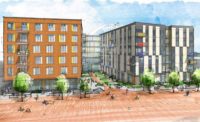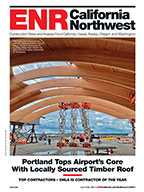Tight construction budgets make it difficult to overcome first cost increases even when coupled with reasonable payback periods. Thankfully, there are a myriad of entities with dollars aimed at encouraging better building practices. These incentives take on a variety of forms, from tax breaks to grants to loans. Seed money is available for new and remodeling projects from large scale commercial all the way down to single family houses. Monies available depend on location, client and project type.
Federal incentives in the United States are fairly limited. The U.S. government generally focuses its investments on increasing the use of renewable energy and upgrading the energy efficiency of existing building stock. Aside from a limited number of grants and loans, dollars come in the form of tax breaks, which means a project still must bear all upfront costs for upgrades.
State and local government carrots for building green in the Pacific Northwest come in a variety of forms and amounts. Oregon has led the way since 1979, with its successful Business Energy Tax Credit program. Unfortunately, BETC came under fire recently, as rule changes made by the legislature in 2007 to encourage renewable energy developments came to be seen by critics as another form of corporate welfare. BETC, which has been a reliable source of money for sustainability measures in buildings for decades, is being reviewed by the State of Oregon legislature.
Noteworthy State ProgramsOregon cities - Portland and Ashland to name two - also have active programs promoting green building. The Portland Bureau of Planning and Sustainability’s Green Investment Fund has been handing out thousands of dollars to projects stretching their sustainability muscles since 2005. No word yet on whether this program will return for a sixth year. Ashland offers a 15% density increase to residential developers incorporating green features into new multi-family developments.
Washington State’s government-funded green building money comes primarily at the municipal level. For example, the state currently offers a sales tax exemption on the purchase of equipment producing electricity using renewable sources, and on energy efficiency upgrades to existing industrial manufacturing plants. The city of Seattle has several programs to encourage green building including a density bonus for LEED projects. Outside Seattle’s city limits, King County has offered grants to commercial LEED gold and platinum certified projects since 2001. In addition, Seattle and King counties co-sponsor a residential grant program called Built Green. Built Green awards money to projects that comply with checklists similar to LEED. Awards typically go to homebuilders, remodelers, multifamily and community developers.
Alaska’s few incentives concentrate on energy efficiency and renewable power. The Alaska Housing Finance Corporation provides money to lower income families for home weatherization. Homeowners who don’t meet the income restrictions can use the state’s second mortgage and energy rebate programs to bring down their energy bills. Alaska Energy Authority’s Renewable Energy Fund was established in 2008. The AEA’s 2009-2010 round of grants for funding renewable projects, including everything from photovoltaics to geothermal, will wrap up at the end of June.

RERICK
Utilities provide a source of green building incentives in almost all jurisdictions. Electric and gas companies offer grants , loans and rebates to their customers because it is more cost effective to promote efficiency than to accelerate the building of new generation sources. Utility programs vary wildly from small Energy Star appliance rebates to solar installation and building energy efficiency upgrade loans. Finding your way to this money starts with identifying the company that provides power to your building’s location.
Some utilities also have grants available. Oregon customers of Portland General Electric, Pacific Power and/or Northwest Natural Gas can take advantage of Energy Trust’s comprehensive set of incentives covering everything from early design charrettes to commissioning to solar to energy efficiency upgrades. Schools can apply for photovoltaic installations through the Bonneville Environmental Foundation’s “Solar 4R Schools” program.
Keeping Track of Incentiveswww.dsireusa.org
Lona Rerick is an associate and project architect at Yost Grube Hall Architecture (YGH) with over 13 years experience in all phases of architecture and interior design from programming through construction. She has worked on a variety of building types, including the LEED gold certified North Mall Office Building, the first project to be completed under the State of Oregon’s Executive Order on Sustainability. Rerick is an executive board member of the Vancouver Watersheds Council.
Green building incentives are available for nearly every project. Since incentives are constantly changing, even appearing and disappearing from year to year with political changes, it is important to start every project with research. In putting together your project’s incentive package, a variety of factors, including location, project type and even your client, will need to be considered. A great resource to begin with each time is the Database of State Incentives for Renewables & Efficiency (). This is an ongoing project of the North Carolina Solar Center and the Interstate Renewable Energy Council which is administered by National Renewable Energy Laboratory and funded by the U.S. Department of Energy’s Office of Energy Efficiency and Renewable Energy. The funds to help put your best intentions to work in your next green building project are out there. You just have to take the time to find and apply for them.


Post a comment to this article
Report Abusive Comment